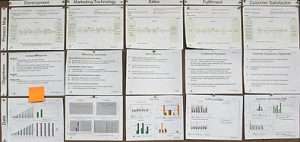What Are Key Performance Metrics KPIs for Software Development?

Are you struggling to track the success of your software development projects? Do you wonder what metrics you should be focusing on to ensure optimal performance? Look no further, because in this article, we will discuss the key performance metrics for software development and how they can benefit you. With constant advancements in technology, it is crucial to understand and utilize these metrics to stay ahead in the competitive market. What Are Key Performance Metrics KPIs for Software Development?
Defining Key Performance Metrics for Software Development
Key performance metrics are crucial in evaluating the success and effectiveness in IT of the software development process. Some important metrics to consider include:
- Defect density: This metric measures the number of defects discovered in the software per lines of code, helping to identify areas for improvement.
- Code coverage: Measuring the percentage of code covered by automated tests ensures thorough testing and reduces the risk of bugs.
- Cycle time: The time it takes for a feature or task to move from development to production can indicate the efficiency of the development process.
- Customer satisfaction: Gathering feedback from users can provide valuable insights into the quality and usability of the software.
Why Are Key Performance Metrics Important in Software Development?
Key performance metrics play a crucial role in software development for various reasons. Firstly, they offer valuable insight into the efficiency and effectiveness of the development process, allowing teams to pinpoint areas for improvement.
Secondly, these metrics enable project managers to monitor progress and ensure that projects are meeting their goals and deadlines. Additionally, key performance metrics aid in resource allocation and budgeting, ensuring that resources are utilized optimally.
Furthermore, these metrics foster communication and collaboration among team members, facilitating better decision-making and problem-solving. Overall, key performance metrics are vital in driving success and achieving desired outcomes in software development.
What Are the Different Types of Key Performance Metrics?
When it comes to measuring the success of software development, there are various key performance metrics that can provide valuable insights. These metrics can be categorized into four main types: productivity, quality, efficiency, and customer satisfaction.
By understanding the different aspects of software development that each metric measures, we can gain a comprehensive understanding of the overall performance of a development team or project. Let’s dive into each type of key performance metric and explore their significance in the software development process.
1. Productivity Metrics
Productivity metrics in software development are essential in measuring the efficiency and effectiveness of the development process. To track and improve productivity, follow these steps:
- Establish clear productivity goals and objectives.
- Gather relevant data, such as lines of code written or features implemented.
- Analyze the data to identify trends and patterns.
Suggestions for enhancing productivity include:
- Offering training and resources to improve developers’ skills.
- Promoting collaboration and communication among team members.
- Utilizing project management tools to streamline workflows and monitor progress.
2. Quality Metrics
Quality metrics play a crucial role in software development as they aid in measuring and ensuring the quality of the software being created. Here are the steps to consider when utilizing quality metrics:
- Define quality objectives and standards to ensure that the software meets the desired level of quality.
- Establish quality metrics, such as defect density, code coverage, and code complexity, to measure the quality of the software.
- Collect data on these metrics throughout the development process to track the quality of the software over time.
- Analyze the collected data to identify any potential quality issues or areas for improvement.
- Utilize the insights gained from the analysis to make necessary adjustments and improvements to the software development process.
- Regularly monitor and review the quality metrics to ensure that the software continues to meet the desired level of quality.
3. Efficiency Metrics
Efficiency metrics are crucial in evaluating the effectiveness of software development processes. To measure and improve these metrics, follow these steps:
- Identify relevant efficiency metrics, such as time and resource utilization.
- Collect data on the identified metrics using tools like time tracking software.
- Analyze the data to identify bottlenecks and areas for improvement.
- Implement process optimizations, such as automation or streamlining workflows.
- Monitor the impact of changes on efficiency metrics to track progress.
By regularly measuring and improving efficiency metrics, software development teams can enhance productivity, reduce waste, and deliver higher-quality products. Additionally, fostering a culture of continuous improvement and providing team members with the necessary resources can further boost efficiency.
4. Customer Satisfaction Metrics
In software development, customer satisfaction metrics play a crucial role as they provide valuable insights into how users perceive the product. These metrics aid in measuring the level of satisfaction customers have with the software, allowing teams to identify areas for improvement and enhance the overall user experience. Some key customer satisfaction metrics include:
- Net Promoter Score (NPS): This metric measures customer loyalty and their likelihood of recommending the product.
- Customer Effort Score (CES): It evaluates the ease of using the software and resolving any issues.
- Customer Satisfaction Score (CSAT): This metric assesses the overall satisfaction of customers with the software.
- User Engagement Metrics: These metrics measure user activity and interaction with the product.
By utilizing these metrics, teams can track progress, address any issues promptly, and continuously improve the software to meet the expectations of their customers.
How Do You Measure Key Performance Metrics in Software Development?

The Bizmanualz Scoreboard displays key segment processes, clearly stated objectives, and on-going performance metrics.
As technology continues to evolve, software development has become an essential aspect of most businesses. However, in order to ensure success and efficiency in this field, it is crucial to have a way to measure the performance of your software development team.
In this section, we will explore the various methods and steps involved in measuring key performance metrics in software development. From setting clear goals and objectives to collecting and analyzing data, we will discuss the key components of effectively measuring the success of your team.
1. Setting Clear Goals and Objectives
Setting clear goals and objectives is a crucial step in software development to ensure alignment and focus. Here are the steps to follow:
- Understand the project requirements and desired outcomes.
- Identify the key deliverables and milestones.
- Break down the goals into specific and measurable objectives.
- Assign responsibilities and define timelines for each objective.
- Communicate the goals and objectives to the entire team.
- Regularly review and update the goals to adapt to changing circumstances.
A true story:
In a software development company, the team was struggling to meet deadlines and deliver quality products. After implementing a process for setting clear goals and objectives, everyone had a shared understanding of what needed to be accomplished. This led to improved collaboration, increased productivity, and ultimately, successful project deliveries.
2. Collecting and Analyzing Data
Collecting and analyzing data is a crucial step in measuring key performance metrics for software development. Here is a list of steps to follow:
- Define the specific metrics you want to measure, such as bug count or customer satisfaction.
- Identify the data sources where relevant information can be obtained, such as issue tracking systems or customer feedback forms.
- Collect the data from these sources, ensuring accuracy and completeness.
- Organize the data in a structured manner, using spreadsheets or specialized software.
- Analyze the data, looking for patterns, trends, and outliers.
- Generate visualizations, such as charts or graphs, to make the data easier to understand and interpret.
- Draw insights from the data analysis, identifying areas of improvement or potential bottlenecks.
- Share the findings with the software development team and stakeholders, promoting transparency and collaboration.
What Are the Most Important Key Performance Metrics for Software Development?
In the fast-paced world of software development, it is crucial to have a way to measure and track the success of a project. This is where key performance metrics come into play. In this section, we will discuss the most important metrics that can help evaluate the effectiveness and efficiency of software development.
From the number of bugs and defects to the return on investment, we will cover the various aspects that contribute to the overall performance of a software development team. By understanding these key metrics, organizations can make informed decisions and continuously improve their development processes.
1. Number of Bugs and Defects
The number of bugs and defects is a crucial performance metric in software development, serving as an indicator of the quality and reliability of a software product. To effectively monitor and manage this metric, follow these steps:
- Implement a bug tracking system to record and prioritize reported issues.
- Regularly perform comprehensive testing to identify and address bugs and defects.
- Track the number of bugs and defects found during each testing phase.
- Analyze the trends and patterns in bug reports to identify recurring issues.
- Set goals for reducing the number of bugs and defects over time.
- Collaborate with developers and testers to continuously improve code quality and testing processes.
True story: A software company implemented a rigorous bug tracking system and invested in comprehensive testing. By diligently monitoring the number of bugs and defects, they were able to significantly improve their software’s stability, resulting in increased customer satisfaction and a decrease in support requests.
2. Time to Market
Time to market is a crucial key performance metric in software development, measuring the time it takes for a product to be developed and released to the market. To ensure efficiency and competitiveness, the following steps can be taken:
- Streamline development processes by adopting agile methodologies and continuous integration.
- Set realistic project deadlines and milestones to keep the development on track and improve time to market.
- Prioritize and focus on essential features to avoid scope creep and reduce time to market.
- Implement effective project management and communication tools to facilitate collaboration and coordination and ultimately improve time to market.
- Regularly evaluate and optimize development workflows to identify bottlenecks and inefficiencies that can delay time to market.
- Invest in automation tools and technologies to speed up testing and deployment processes and improve time to market.
Historically, companies like Apple have mastered time to market, launching innovative products like the iPhone within tight timelines to meet consumer demands and gain a competitive edge.
3. Customer Retention Rate
The retention rate of customers is a crucial measurement in software development that evaluates the percentage of customers who continue to utilize a software product during a designated time frame. This metric is significant as it reflects customer satisfaction, loyalty, and the software’s effectiveness in fulfilling their requirements.
A high customer retention rate indicates that the software is meeting expectations and delivering value, while a low rate may indicate underlying issues that need to be resolved. By closely monitoring and enhancing the customer retention rate, software development teams can secure long-term success and cultivate strong relationships with their customers.
4. Code Quality and Maintainability
Code quality and maintainability are two crucial metrics that determine the performance of software development. These metrics evaluate the effectiveness and efficiency of the codebase, ensuring that it is easily readable, scalable, and maintainable. To assess code quality, developers utilize various techniques such as code reviews, static code analysis, and automated testing.
They also prioritize maintainability, which involves making sure that the code can be easily modified or updated without causing any issues. By giving importance to code quality and maintainability, software development teams can reduce technical debt, increase productivity, and deliver top-notch software products.
Regular code refactoring and adherence to coding best practices are critical in achieving these objectives.
5. Customer Satisfaction and Feedback
Customer satisfaction and feedback are crucial factors in software development. To ensure high levels of satisfaction and gather valuable feedback, follow these steps:
- Implement a feedback system: Set up a mechanism for customers to easily provide feedback, such as a feedback form or dedicated email address.
- Regularly collect feedback: Encourage customers to share their thoughts and experiences throughout the software development process.
- Analyze feedback: Carefully review and analyze customer feedback to identify areas of improvement and address any issues or concerns.
- Act on feedback: Use the feedback received to make necessary changes and enhancements to the software, ensuring that customer needs and expectations are met.
- Continuously monitor satisfaction: Regularly measure customer satisfaction levels to track progress and identify opportunities for further improvement.
A software development company implemented a feedback system and actively sought customer feedback. By promptly addressing customer concerns and incorporating their suggestions, they were able to improve their software, leading to increased customer satisfaction and loyalty.
6. Return on Investment
Return on Investment (ROI) is a crucial key performance metric in software development. It measures the profitability of an investment in software development, indicating the financial return generated compared to the initial investment.
A high ROI signifies successful project execution and efficient resource allocation. By analyzing ROI, organizations can make informed decisions about future investments and prioritize projects with the highest potential for financial gain.
To calculate ROI, divide the net profit from the software development project by the total investment cost and express it as a percentage. Continuous monitoring and improvement of ROI can ultimately contribute to the overall success and profitability of software development endeavors.
How Can Key Performance Metrics Improve Software Development Processes?

What are Key Performance Metrics KPIs for Software Development
In the fast-paced world of software development, it is crucial to constantly strive for improvement and efficiency. This is where key performance metrics come into play. By measuring specific aspects of the development process, these metrics can provide valuable insights on areas for improvement, track progress and success, motivate team members, and identify and address issues early on. In this section, we will delve into the ways in which key performance metrics can enhance software development processes and ultimately lead to better outcomes.
1. Identifying Areas for Improvement
Identifying areas for improvement is crucial in software development to ensure continuous growth and efficiency. Here are steps to identify areas for improvement:
- Review current processes and workflows to identify bottlenecks or inefficiencies.
- Collect and analyze data on key performance metrics, such as productivity, quality, and customer satisfaction.
- Seek feedback from team members and stakeholders to understand pain points and areas of frustration.
- Compare performance metrics to industry benchmarks and best practices to identify gaps.
- Conduct regular retrospective meetings to reflect on past projects and identify areas for improvement.
- Implement changes and measure the impact on performance metrics.
By following these steps, software development teams can proactively identify areas for improvement and optimize their processes for better outcomes.
2. Tracking Progress and Success
Tracking progress and success in software development is crucial for evaluating project performance and ensuring timely delivery. Here are the steps to effectively track progress and success:
- Establish clear objectives and milestones at the beginning of the project.
- Regularly collect and analyze data on key performance metrics, such as productivity, quality, and customer satisfaction, to track progress and success.
- Identify trends and patterns in the data to gain insights on project progress and identify areas for improvement.
- Utilize project management tools and software to monitor tasks, timelines, and milestones.
- Conduct regular project reviews and retrospective meetings to evaluate progress and address any issues or bottlenecks.
- Implement a system for reporting project status and progress to stakeholders.
- Celebrate milestones and successes to boost team morale and motivation.
By following these steps, software development teams can effectively track progress and success, resulting in improved project outcomes and satisfied clients.
3. Motivating Team Members
Motivating team members is crucial for the success of software development projects. To achieve this, here are some steps you can take to encourage and inspire your team:
- Regularly recognize and appreciate their efforts and achievements.
- Provide opportunities for growth and learning through training programs or conferences.
- Encourage collaboration and teamwork by fostering effective communication and maintaining a positive work environment.
- Set clear and achievable goals, allowing team members to take ownership of their tasks.
- Boost morale by offering incentives and rewards for exceptional performance.
- Empower team members by giving them autonomy and responsibility in decision-making.
By implementing these strategies, you can effectively motivate your team members and create a productive and cohesive software development team.
4. Identifying and Addressing Issues Early On
Identifying and addressing issues early on is crucial in software development as it helps prevent further complications and ensures timely delivery of high-quality products. Here are steps to achieve this:
- Regular code reviews to catch and fix errors before they become major issues.
- Continuous integration and automated testing to detect bugs and defects early.
- Implementing agile practices like daily stand-ups and sprint retrospectives to promote open communication and issue identification.
- Utilizing project management tools to track progress and identify any deviations from the initial plan.
- Regularly collecting and analyzing user feedback to address any usability or functionality issues promptly.
Key Performance Metrics KPIs for Software Development
For a number of reasons, key performance metrics are important in software development. They provide insightful information about the efficacy and efficiency of the development process, enabling teams to identify areas in need of improvement.
With the use of these metrics, project managers can keep an eye on developments and make sure that deadlines and objectives are being met. Key performance metrics also help with budgeting and resource allocation, ensuring that resources are used as efficiently as possible.
Moreover, these metrics encourage team members to communicate and work together, which improves decision-making and problem-solving. In software development, key performance metrics play a critical role in propelling success and realizing intended results.
Frequently Asked Questions

What are Key Performance Metrics for Software Development?
Key Performance Metrics for Software Development are quantifiable measurements used to evaluate the success and efficiency of a software development team and their projects. These metrics help to track progress, identify areas for improvement, and make data-driven decisions.
Why are Key Performance Metrics important for Software Development?
Key Performance Metrics are important for Software Development because they provide valuable insights into the effectiveness and productivity of a development team. By tracking these metrics, teams can identify and address issues, set realistic goals, and measure their progress towards achieving them.
What are some examples of Key Performance Metrics for Software Development?
Some examples of Key Performance Metrics for Software Development include lead time, cycle time, bug resolution time, code coverage, customer satisfaction, and team velocity. Other metrics may also include code quality, project cost, and project success rate.
How are Key Performance Metrics measured for Software Development?
Key Performance Metrics for Software Development are typically measured using specialized tools and software, such as project management software, code quality analysis tools, and customer satisfaction surveys. These tools can collect and analyze data, providing accurate and objective measurements.
What are the benefits of using Key Performance Metrics for Software Development?
The benefits of using Key Performance Metrics for Software Development include improved productivity, better decision-making, increased transparency, and enhanced team collaboration. By tracking these metrics, teams can also identify and address issues early on, leading to higher quality products and better customer satisfaction.
How often should Key Performance Metrics be reviewed for Software Development?
Key Performance Metrics for Software Development should be reviewed regularly, ideally on a monthly or quarterly basis. This allows teams to track progress, identify trends, and make necessary adjustments to improve performance and achieve their goals.

















Leave a Reply